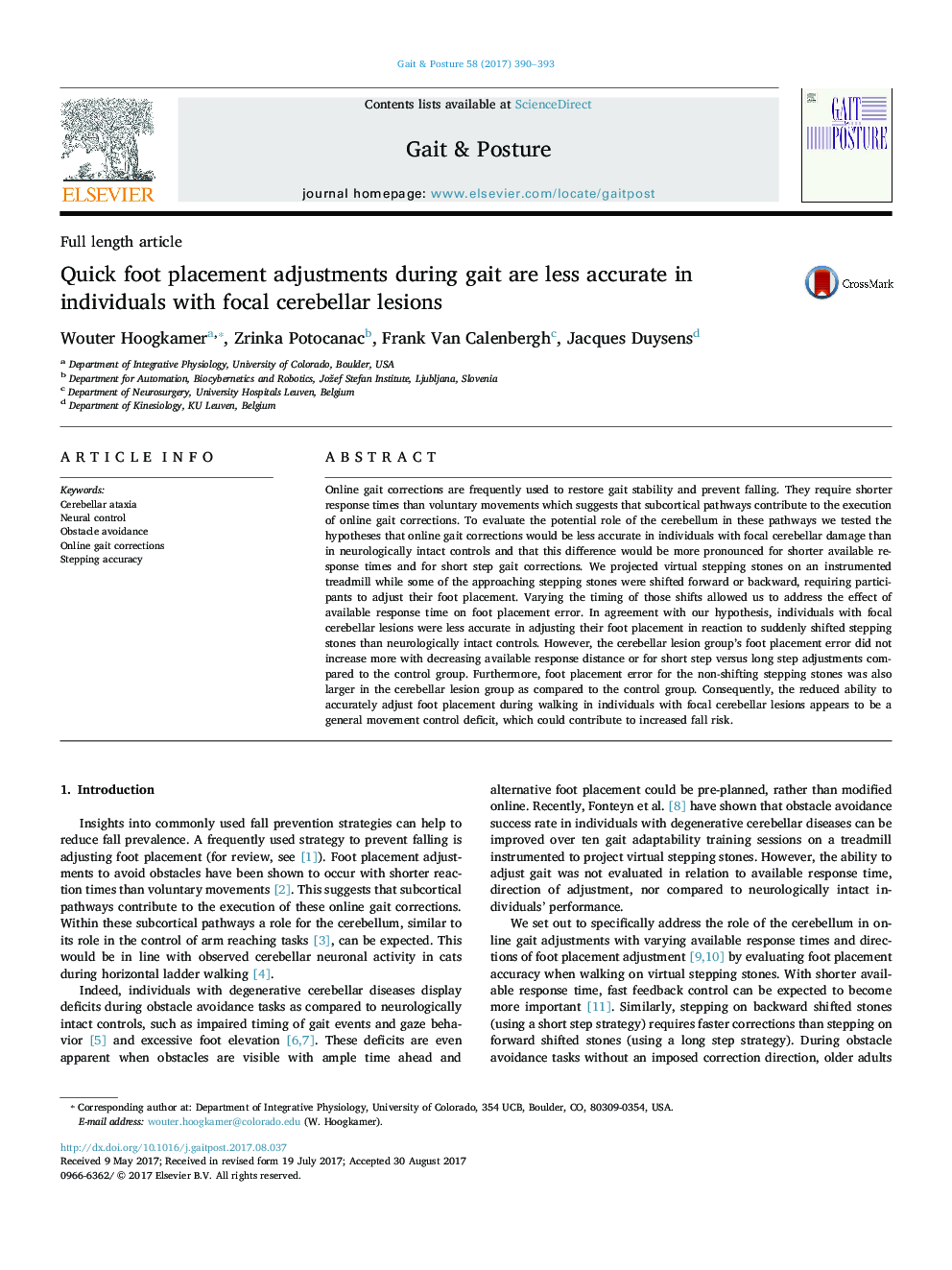| کد مقاله | کد نشریه | سال انتشار | مقاله انگلیسی | نسخه تمام متن |
|---|---|---|---|---|
| 5707642 | 1603837 | 2017 | 4 صفحه PDF | دانلود رایگان |
عنوان انگلیسی مقاله ISI
Quick foot placement adjustments during gait are less accurate in individuals with focal cerebellar lesions
ترجمه فارسی عنوان
تنظیمات حرکت سریع پا در هنگام راه رفتن در افراد مبتلا به ضایعات مغزی مرکزی دقیق تر است
دانلود مقاله + سفارش ترجمه
دانلود مقاله ISI انگلیسی
رایگان برای ایرانیان
کلمات کلیدی
ترجمه چکیده
اصلاحات راه رفتن آنلاین اغلب برای بازسازی ثبات راه رفتن و جلوگیری از سقوط استفاده می شود. آنها نیاز به زمان پاسخ کوتاهتری نسبت به حرکات داوطلبانه دارند که نشان می دهد مسیرهای زیرکوه به انجام اصلاحات گشت و گذار آنلاین کمک می کنند. برای ارزیابی نقش بالقوه مخچه در این مسیرها، ما فرضیه ها را بررسی کردیم که اصلاح راه رفتن آنلاین در افراد مبتلا به آسیب مغزی متمرکز کمتر از کنترل های عصبی مصنوعی است و این تفاوت برای زمان پاسخ کوتاه تر و کوتاه تر اصلاحات قدم به قدم ما سنگهای مجازی پراکنده را بر روی یک تردمیل وسیله ای نصب کردیم، در حالیکه بعضی از سنگ های پله ای که در حال نزدیک شدن بودند، به سمت جلو یا عقب حرکت می کردند و شرکت ها مجبور بودند که پای خود را تنظیم کنند. تغییر زمان این تغییرات به ما امکان رسیدگی به تأثیر زمان پاسخدهی در خطای قرار دادن پا را دادیم. در هماهنگی با فرضیه ما، افراد مبتلا به ضایعات کانونی مغناطیسی در تعدیل قرار دادن پای خود در واکنش به سنگ های پیاپی ناگهان منتقل شده نسبت به کنترل های عصبی مصون نبودند. با این وجود، خطای قرار دادن پا در گروه ضایعه مخچه، با کاهش فاصله در دسترس پاسخ یا گام کوتاه در مقایسه با تنظیمات طولانی مدت در مقایسه با گروه کنترل افزایش نیافت. علاوه بر این، خطای قرار دادن پایه برای سنگ های غیر قابل تغییر سنگ نیز در گروه ضایعه مخچه در مقایسه با گروه کنترل بزرگتر بود. در نتیجه، توانایی کاهش دقت تنظیم پای پا در حین پیاده روی در افراد مبتلا به ضایعات کانونی مغناطیسی، به نظر می رسد کمبود کنترل عمومی جنبش است که می تواند منجر به افزایش خطر سقوط شود.
موضوعات مرتبط
علوم پزشکی و سلامت
پزشکی و دندانپزشکی
ارتوپدی، پزشکی ورزشی و توانبخشی
چکیده انگلیسی
Online gait corrections are frequently used to restore gait stability and prevent falling. They require shorter response times than voluntary movements which suggests that subcortical pathways contribute to the execution of online gait corrections. To evaluate the potential role of the cerebellum in these pathways we tested the hypotheses that online gait corrections would be less accurate in individuals with focal cerebellar damage than in neurologically intact controls and that this difference would be more pronounced for shorter available response times and for short step gait corrections. We projected virtual stepping stones on an instrumented treadmill while some of the approaching stepping stones were shifted forward or backward, requiring participants to adjust their foot placement. Varying the timing of those shifts allowed us to address the effect of available response time on foot placement error. In agreement with our hypothesis, individuals with focal cerebellar lesions were less accurate in adjusting their foot placement in reaction to suddenly shifted stepping stones than neurologically intact controls. However, the cerebellar lesion group's foot placement error did not increase more with decreasing available response distance or for short step versus long step adjustments compared to the control group. Furthermore, foot placement error for the non-shifting stepping stones was also larger in the cerebellar lesion group as compared to the control group. Consequently, the reduced ability to accurately adjust foot placement during walking in individuals with focal cerebellar lesions appears to be a general movement control deficit, which could contribute to increased fall risk.
ناشر
Database: Elsevier - ScienceDirect (ساینس دایرکت)
Journal: Gait & Posture - Volume 58, October 2017, Pages 390-393
Journal: Gait & Posture - Volume 58, October 2017, Pages 390-393
نویسندگان
Wouter Hoogkamer, Zrinka Potocanac, Frank Van Calenbergh, Jacques Duysens,
